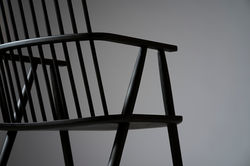 |
|---|
 |
 |
 |
 |
 |
 |
POSSUM CHAIR
personal work
material : beech wood
In an age when globalization has accelerated the exchange of people and things, leading to the homogenization of everything, I wondered if it was possible to create furniture that forms naturally and slowly, much like the evolution of organisms or the passing down of stories.
The development of this chair was sparked by my curiosity about the Jimmy Possum chair, which was made in Northern Tasmania in Australia from the late 19th to the early 20th century.
What fascinates me most about the Possum chair is that the identity of the original creator is still unclear. It is said that a man named Jimmy Possum started making these chairs and they gradually spread throughout Northern Tasmania, a tale akin to an old legend. All that remains today is this tale and a portrait of a man believed to be Jimmy Possum, painted in the first half of the 20th century, which continues to be passed down through the generations.
Looking at the original chairs, they were crafted from solid wood using hand tools like drawknives and axes, without special machinery. The legs, rising from the floor through the seat to support the armrests, is a distinctive feature. It's also designed so that when sat upon, the legs and seat join more firmly, revealing it to be a chair made rationally with only the most necessary tools and materials.
I imagined how this chair would have evolved as a piece of modern furniture if its lore had spread beyond Tasmania to neighboring regions and Asia. Paying homage to its history, I attempted a redesign suitable for contemporary furniture. The wood I chose is domestically produced beech, known for its workability and suitable flexibility. The legs and back spokes were made using a wood lathe, while the seat, armrests, and back were mostly shaped using hand tools like spokeshaves and drawknives. Maintaining the original features of the Possum chair, including the
relationship between the arms, seat, and legs, and its main structure, I aimed to improve comfort by finishing the backrest and seat with organic forms.
グローバル化によりヒトやモノの往来が加速しあらゆるものが均一化に進む現代において、まるで生物の進化のように、あるいは物語の伝承のように無理なくゆっくりと形作られるような家具が作れないだろうか。
この椅子は、19 世紀の後半から20 世紀初頭にかけてオーストラリアのタスマニア北部で作られていたジミー・ポッサムチェアへの私自身の知的好奇心がきっかけとり開発を始めた。
ポッサムチェアの最も興味深い点はオリジナルの作者が未だに誰なのかはっきりせず、大木の洞に住むジミー・ポッサムという男がこの椅子を作りはじめ、その製法がタスマニアの北部でしだいに広まっていったという昔話と、20 世紀前半にとある画家が描いたジミーポッサムとされる一枚の肖像画だけが今も残っており現代に語り継がれている点である。
現存するオリジナルのチェアを見ると、特別な機械を使わずにドローナイフや斧のようなハンドツールで無垢材を削って作られており、座面を突き抜ける床から伸びた脚がハンドレストを支える構造が最大の特徴である。さらに、座ると脚と座面がより強固に接合される構造になっており、必要最低限の道具と材料だけで合理的に作られた椅子であることがわかる。そこで私は、この椅子がタスマニアに留まらず、その伝承がオーストラリアを中心に近隣の地域やアジアにまで及び、現代家具として進化を遂げているとすればどのような形状に変化を遂げたのか想像し、この椅子の歴史に敬意を払いながらも現代の家具としてリデザインを試みた。
木材は加工性に富み適度なしなりを持つ国産のブナ材を使用している。脚や背もたれのスポークスは木工旋盤を使用し、座面やアームレスト、背もたれは主にスポークシェーブやドローナイフ、鉋等のハンドツールで形を削り出している。オリジナルのポッサムチェアの特徴であるアームと座面・脚の関係性や主な構造はそのまま残し、背もたれやシートを有機的なフォルムに仕上げることで座り心地の向上を狙った。